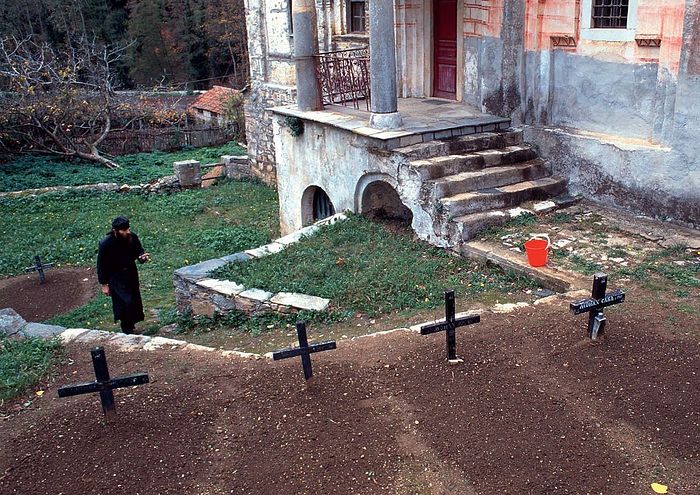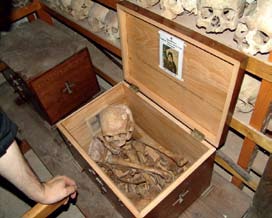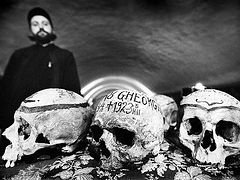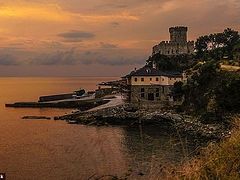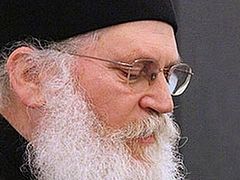The monasteries of Mt. Athos are hundreds of years old, and hundreds and thousands of monks have ended their earthly lives in them. But where are all of the graves of the reposed? Can it really be that the monks just don’t consider it necessary to take care to preserve the memory of their deceased brothers?
Purity of soul
Anyone that visits Mt. Athos’ monasteries will notice two peculiar things: first, even large monasteries have small cemeteries with only a few wooden crosses mounted in the ground; second, the oldest burials in these cemeteries are, at best, twenty or so years old. But how could that be?
First of all, let’s take note of the fact that Athonite monks are usually always buried on Mt. Athos itself. However, it does sometimes happen though that an Athonite monk due to various circumstances may end up living in another monastery outside of Mt. Athos and thus will be buried there instead. For example, at the Danilov cemetery in Moscow can be found the revered grave of the Athonite monk Aristoklis (Amvrosiev), who for many years had presided over the Athonite metochion in Moscow and thus was buried in Moscow after he reposed. However, any monk that reposes on Mount Athos, even if he had come to the Holy Mountain from another country for the first time, is not taken to his homeland to be buried, but is buried at the same Athos monastery in which he had reposed.
To repose on the Holy Mountain, in fact, is actually considered a kind of recognition of the deceased's righteousness and almost a guarantee of the salvation of his soul. An Athonite monk of our time, hieromonk Gabriel, would always say, “What a joy it is to die on Athos! Here, the Mother of God herself meets the monk after his death, guiding his soul on its way from Earth to Heaven…”
On Mt. Athos, according to tradition, the burial of the deceased is preceded by a special rite. Also, the deceased monk’s clothes will not be changed and neither will his body be washed before burial. On the one hand, proper hygiene is, of course, always maintained; on the other, too much care for the body and health in general is considered an unnecessary occupation, not worthy of a monk’s time. And in fact, this manner of burial is not exactly something unique to Athonite monasticism. For example, in the “Monastic Rite of Burial" we read the following: "When a monk reposes in the Lord, it is not appropriate for his body to be washed or be seen unclad."
The deceased instead will first be clothed in a “schema” and his head will be covered with a “koukoulion” (attire worn by schemamonks). Afterwards, a cassock is sewn over the body, serving as a coffin for the deceased, and an icon of the Holy Virgin Mary is placed on his chest. It’s worth noting that usually during burial procedure the icon of the Virgin Mary is only given to women, while men are given the icon of the Savior. But, since Mt. Athos is considered to be a place where the Mother of God is especially present, and according to belief, is the first to meet the souls of the deceased, the funeral traditions that have formed here are unique.
Generally burial takes place on Mount Athos on the day of death and without a coffin, so that the body may return unto the ground as soon as possible. Such a burial practice is actually common in many religions and cultures. In particular, Abrahamic religions adhere to this rule in accordance with the words that God addressed to Adam before his exile from Paradise: In the sweat of thy face shalt thou eat bread, till thou return unto the ground; for out of it wast thou taken: for dust thou art, and unto dust shalt thou return (Gen. 3:19).
After the customary prayer rule is read, the deceased monk is carried by his fellow brethren to his place of rest and is buried. Afterwards, on top of the grave the brethren mount a low four-pointed wooden cross on which, using simple paint, is made the most concise inscription: the name of the monk and the date of his death.
Stone after stone
It should be noted that the Athonite grave, that is, the very ground that the body is buried under, is much different than it is elsewhere. For example, the ground in Russia, which is mostly flatland, does not share in common any of the burial-related problems that inhabitants of the Mediterranean and other mountainous areas face. In Russia, the usual environment where the body of the deceased is placed is usually a homogeneous, soft, crumbly mass: at best, it is soil or sand; at worst—clay. On Mount Athos however there is nothing of the sort. Mt. Athos is all stone. Sometimes the ground is just a single stone mass, but more often it consists of cobblestones and large gravel. Soil on Mount Athos is in deficit even more than wood is. Therefore, agriculture on the peninsula is practically absent—there are no appropriate conditions for it. By the way, some time ago in the past, the Russian Panteleimon monastery on Mt. Athos had soil delivered to it by sea so that the monks, despite harsh conditions, would nonetheless be able to plant a few gardens. During our trip we happened to see some monasteries that had a bit of farmland, which at best had a few dozen rows of cabbages and some kind of gourds. The largest garden we saw was at the Great Lavra monastery, which had about 40 yards of land. And, no doubt, the soil for this garden was also brought from elsewhere, for the ground around the monastery is mostly all stone. As for the ground of the surrounding roads, it is either siliceous or consists of dense red soil resembling something like grated brick.
Now let’s take a look at the following scenario: a monk in one of the Athonite monasteries reposes in the Lord. In order to bury him, the brethren of the monastery have to urgently fulfill an extremely laborious obedience—prepare the place of burial for their deceased brother. Let us not forget that the deceased, according to monastic customs, are buried as soon as possible, usually on the very day of their death. Little by little, or rather, stone by the stone, the hardworking monks, with their shovels ringing, dig through the rough terrain of Mt. Athos. Finally, the grave is complete and the body of the deceased brother is gently placed within. But now what? Will they really fill the grave back up with all those stones and boulders they just dug up?! For a cause such as this they do manage to find enough soil. Now let us again keep in mind the deficit of soil on Mt. Athos, as this circumstance will soon help us understand the reason behind other important burial customs on the Holy Mountain.
With the grave now covered and topped off with a small mound of earth, and the wooden cross with its inscription mounted in place, the burial is complete. Now, here is the incomprehensible part of the procedure to one who is not familiar with Athonite burial customs: In just three years’ time the grave will be dug up, and the deceased brother’s bones will never again return to their former place of rest!
On Mt. Athos, a monastery brotherhood prays for newly-reposed monks with especial assiduousness. For the first 40 days, the entire brotherhood of the monastery reads the customary prayer rule for the reposed, repeating it according to the amount of knots on their prayer ropes. Also, in memory of the reposed monk, the monastery prepares “kolivo” (also called “kutia” in Russia), a ritual memorial dish which consists of some grain such as wheat, rye, oat, or rice, as well as honey, raisins and nuts. Furthermore, for the following three years the deceased is commemorated at every Liturgy during the proskomedia. Now bearing in mind that the Divine Liturgy in the monasteries is served daily, this means that the deceased monk receives commemoration every day and for quite a long time. Finally, the name of the deceased is also recorded in a special memorial monastery book, the so-called “Kuvaras”, which bears record of the names of all the deceased monks that have lived in the monastery from the time of its very foundation. For example, the “Kuvaras” of the Great Lavra monastery, read during special memorial days, has been recording the names of its brethren to this very day since the 10th century!
The ossuary
After three years have passed, the grave of the newly-reposed monk is carefully dug up and the brethren now examine the remains of the deceased to see what state they are in. If the soft tissues of the body are not completely decomposed yet, the grave will be covered up in likewise manner and the following procedure will be repeated again until it is clear that only the bones remain. By the way, according to Athonite tradition, a body that is not “accepted by the earth”, i.e., doesn’t decompose, is regarded as a sign that the monk did not make the effort to lead a proper monastic way of life and that his soul has not found rest in Heaven. In such case, the entire brotherhood begins to pray even more diligently, beseeching the Lord for the forgiveness of sins and purification of their fellow brother’s soul.
If the bones of the deceased are completely free from flesh (and this, under the Athos climate, while also taking into account the terrain, occurs most often in just about three years), they are taken out of the grave, and after being thoroughly washed with water and wine are transferred to the ossuary, which is a building that resembles a chapel and is usually located somewhere nearby, outside the walls of the monastery. As for the empty grave, it’s now ready to grant rest for another three years to someone else after his repose.
So now we know how Mt. Athos manages to solve the problem of soil deficit and why there are so few graves in the cemeteries of these ancient monasteries. As it turns out, there can’t possibly be too many graves, as there is a constant “rotation” going on that many at first aren’t aware of.
Now an ossuary is, in essence, a crypt. But the peculiarity of this crypt lies in the fact that the deceased, or rather, their remains, are not hidden there, but are in plain sight: the skulls are lined up in rows along the shelves, while the other bones are neatly laid right on the floor along the walls. The names of the monks and the date of their death are usually found written on each skull. Here is how the well-known Russian writer Boris Zaitsev, who visited Mount Athos at the beginning of the 20th century, described the ossuary of the Skete of Saint Andrew: "The ossuary of St. Andrew's Skete is a rather large, secluded and well-lit room on an underground floor. Inside the ossuary is found a cupboard with five human skulls. On each is inscribed a name and a date. These were the abbots of the skete. Then on the shelves lay the skulls (about seven hundred) of ordinary monks, which also have inscriptions. And, finally, what to me seemed most incredible—small bones (the hands and feet) were neatly put together in stacks near the wall, reaching up almost to the ceiling. All this was done with the most profound care that is inherent to this kind of burial tradition. It seemed to me that the only thing missing from this whole picture was a monk that would spend time here keeping record of things and compiling biographies of the reposed brethren. There is some literature present here as well. On the wall here, by the way, hangs a saying that the brethren themselves composed: "Remember, O brethren, that we were once like you, and you will once become like us."
Thus, in such a manner do the Athonite monks lay at rest after reposing in the Lord, with the ossuary basically serving them as a common mass grave. It’s also worth noting that on Athos it is thought that the color of the skull of a reposed monk is a sure sign of whether or not the monk’s life was well-pleasing to God. Thus, according to this belief, the skulls of the righteous have a beautiful yellowish shade—they look as though they are emitting light, and, sometimes even produce a sweet-smelling scent; the monks that have honestly carried out their monastic vows have white-colored skulls; and a dark colored skull, on the other hand, signifies that the judgment of the departed monk’s soul due to his sins did not have a positive outcome. The last case, however, is quite rare on Mt. Athos.
Mt. Athos' ossuaries are never locked. Any inhabitant of the monastery can at any time can enter the ossuary and in solitude reflect on the transience of life. Looking at the bones of monks whom one once knew, or of those who had reposed centuries ago, it is unlikely that one would not come to the thought that they themselves will one day also find rest here along with their fellow brethren. Now that is truly something to ponder for the monk... However, monks do not at all fear ending up here in this gloomy house of bones, knowing for certain that there is no need to fear death, for it has already been defeated by the Risen Christ!

